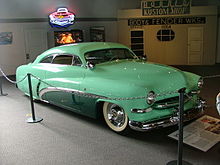
Shaved doors are doors on an automobile that do not have handles on the outside of the vehicle, in order to present in a smooth look. [1] [2] [3] It was pioneered by customiser Harry Westergard in California. [4] [5] [6] The modification also increases security as there is no keyhole to pick or handle to grab.
Often called autolocs, or autoloc doors, after a popular manufacturer of such doors.
Shaved doors are popular on hot rods, street rods, muscle cars, tuned cars (mostly Japanese), trucks, and mini trucks. It is also a traditional modification on many lead sleds, dating back to the 1940s. A solenoid is used to open the door. This solenoid can be triggered by button or remote. They can also be opened mechanically with a hidden cable release. [1]